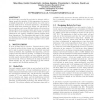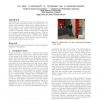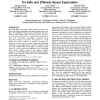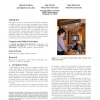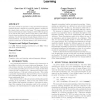HRI
2006
ACM
14 years 5 months ago
2006
ACM
The design and development of social robots that interact and assist people in daily life requires moving into unconstrained daily-life environments. This presents unexplored meth...
HRI
2006
ACM
14 years 5 months ago
2006
ACM
As robots enter everyday life and start to interact with ordinary people the question of their appearance becomes increasingly important. A user’s perception of a robot can be s...
HRI
2006
ACM
14 years 5 months ago
2006
ACM
The essence of the signal-to-symbol problem consists of associating a symbolic description of an object (e.g., a chair) to a signal (e.g., an image) that captures the real object....
HRI
2006
ACM
14 years 5 months ago
2006
ACM
Autonomous robots use sensors to perceive and track objects in the world. Tracking algorithms use object motion models to estimate the position of a moving object. Tracking effic...
HRI
2006
ACM
14 years 5 months ago
2006
ACM
Interacting with a domestic service robot implies the existence of a joint environment model for user and robot. To enable robot navigation within such a setting requires further ...
HRI
2006
ACM
14 years 5 months ago
2006
ACM
HRI
2006
ACM
14 years 5 months ago
2006
ACM
This paper reports on the results of a long-term experiment in which a social robot’s facial expressions were changed to reflect different moods. While the facial changes in e...
HRI
2006
ACM
14 years 5 months ago
2006
ACM
The paper presents an approach to using structural descriptions, obtained through a human-robot tutoring dialogue, as labels for the visual object models a robot learns. The paper...
HRI
2006
ACM
14 years 5 months ago
2006
ACM
Programming robots to carry out useful tasks is both a complex and non-trivial exercise. A simple and intuitive method to allow humans to train and shape robot behaviour is clearl...
HRI
2006
ACM
14 years 5 months ago
2006
ACM
We report a study of a human-robot system composed of a science team (located in Pittsburgh), an engineering team (located in Chile), and a robot (located in Chile). We performed ...

